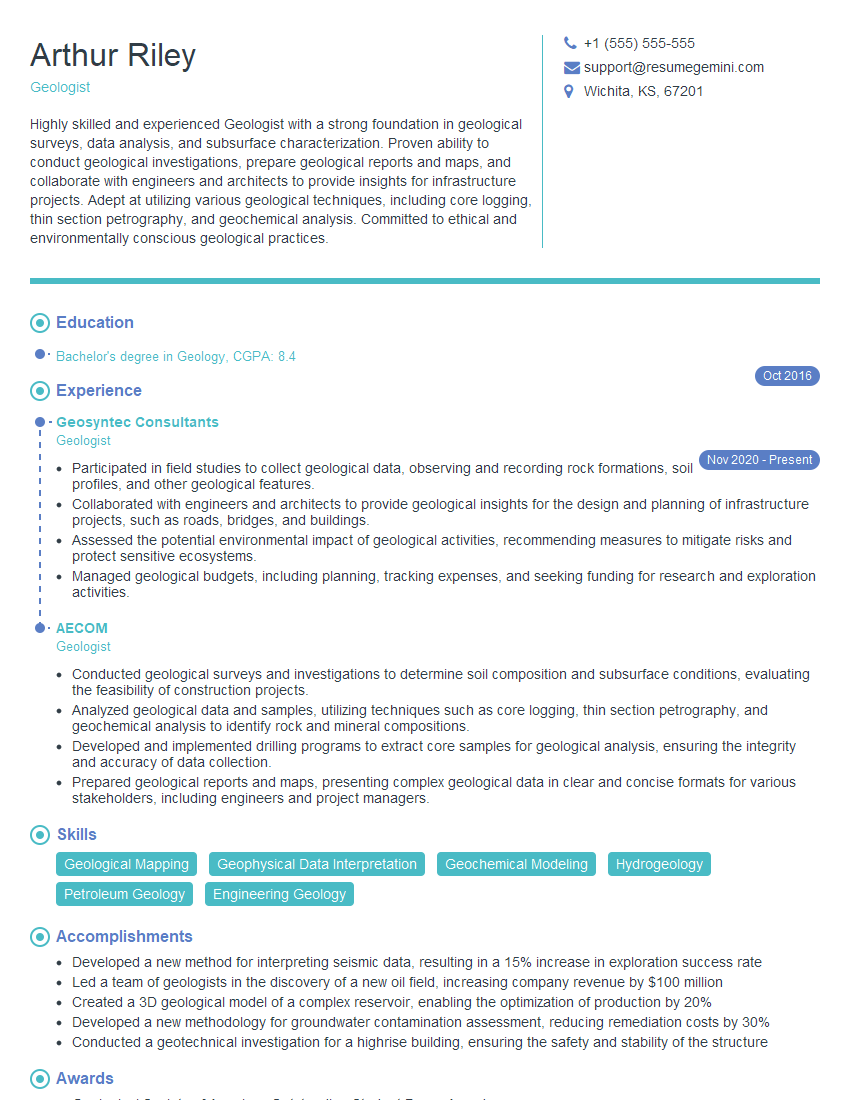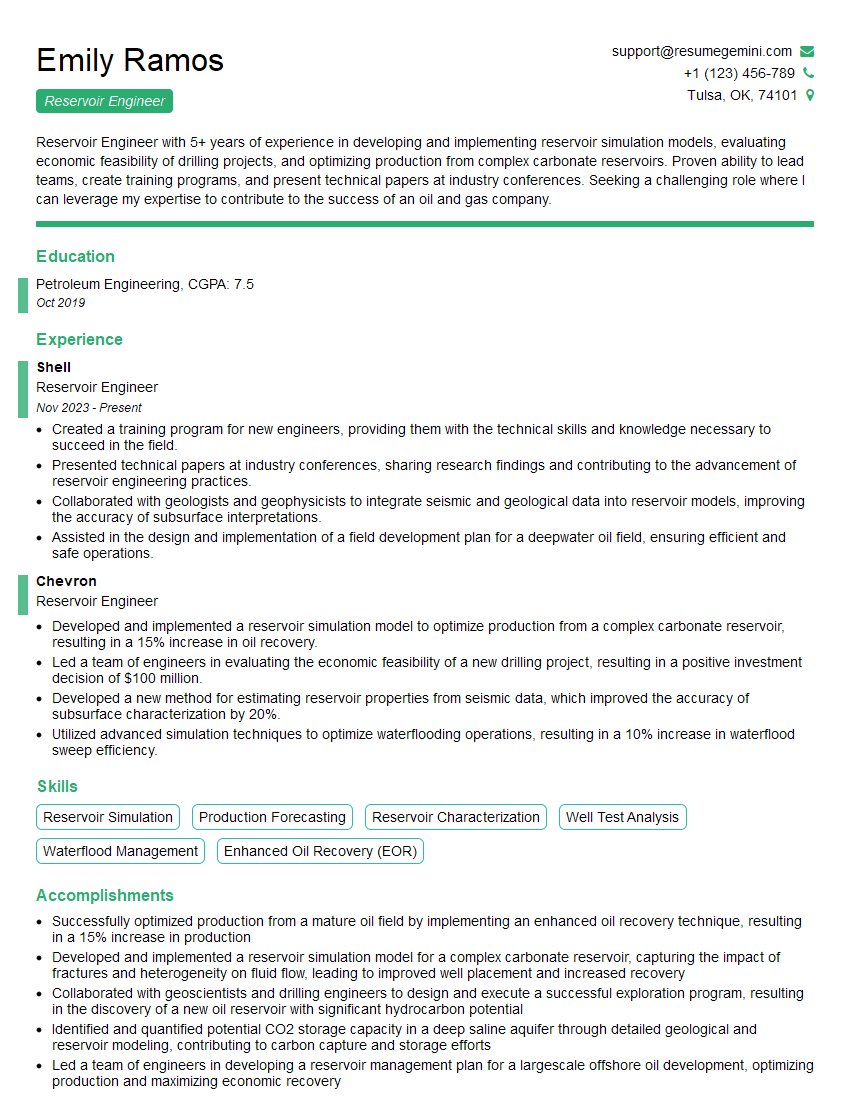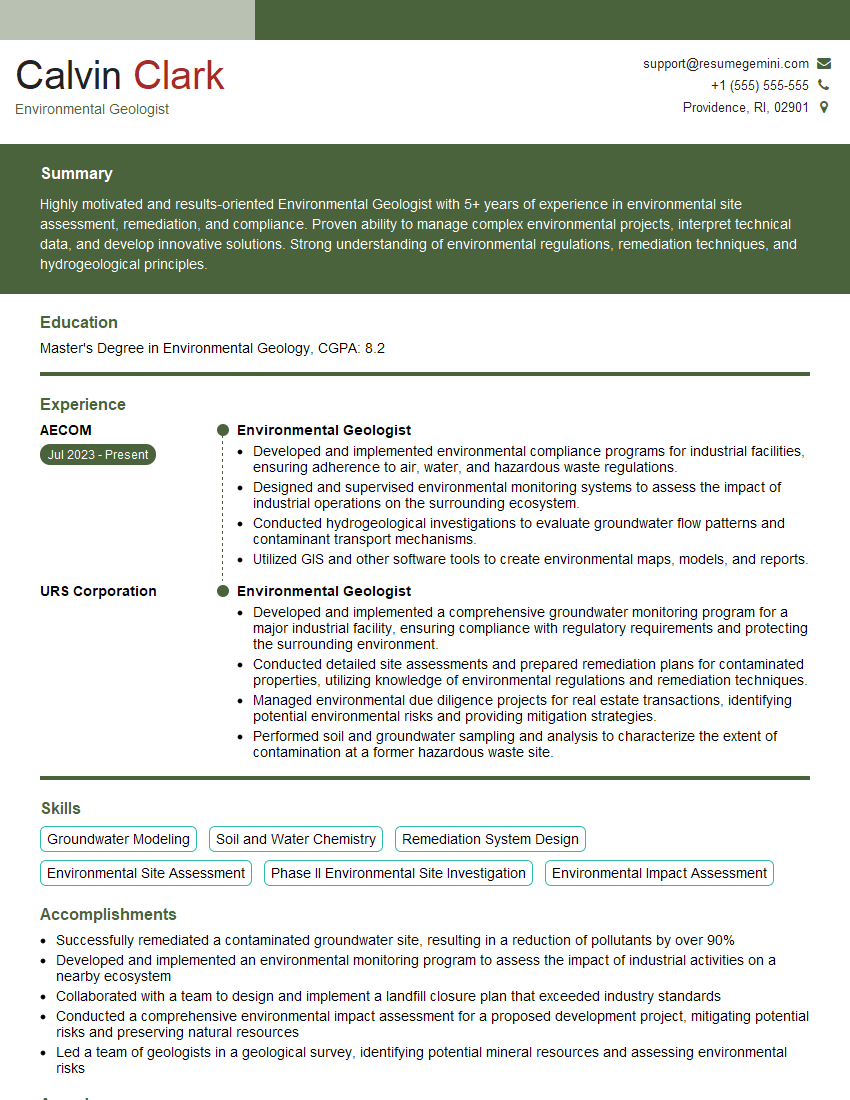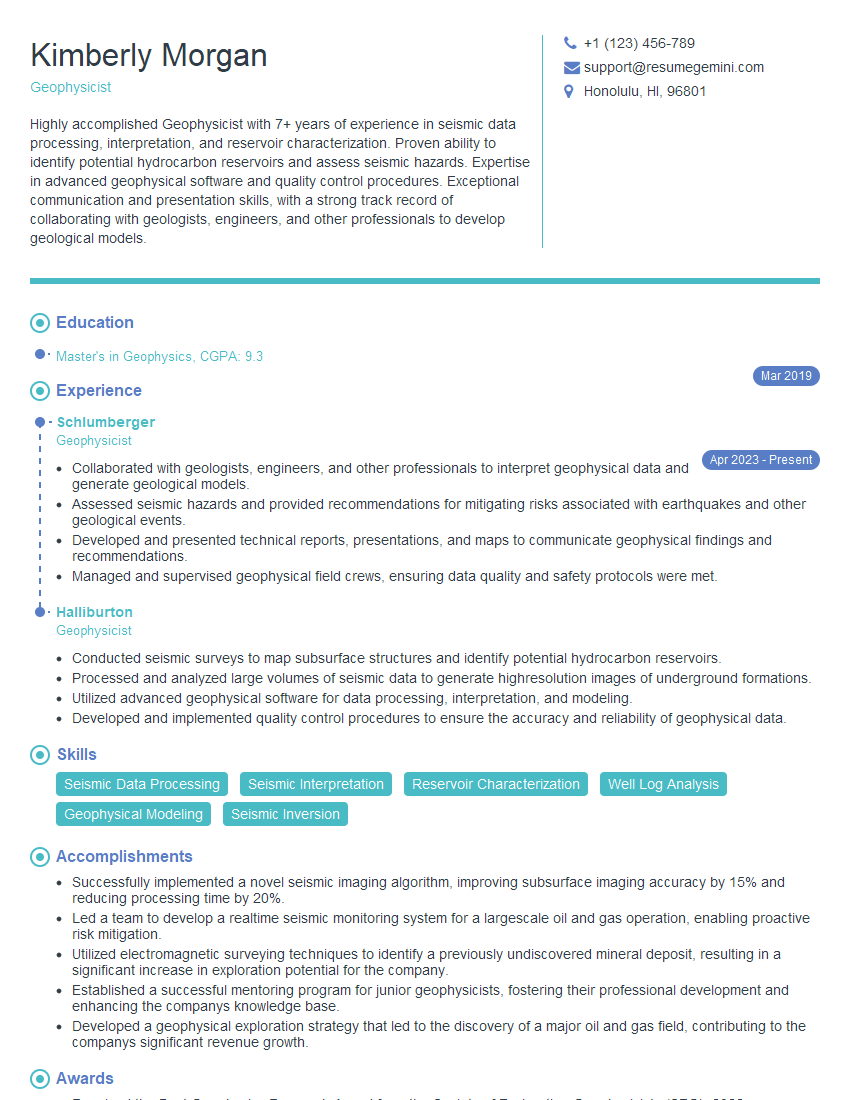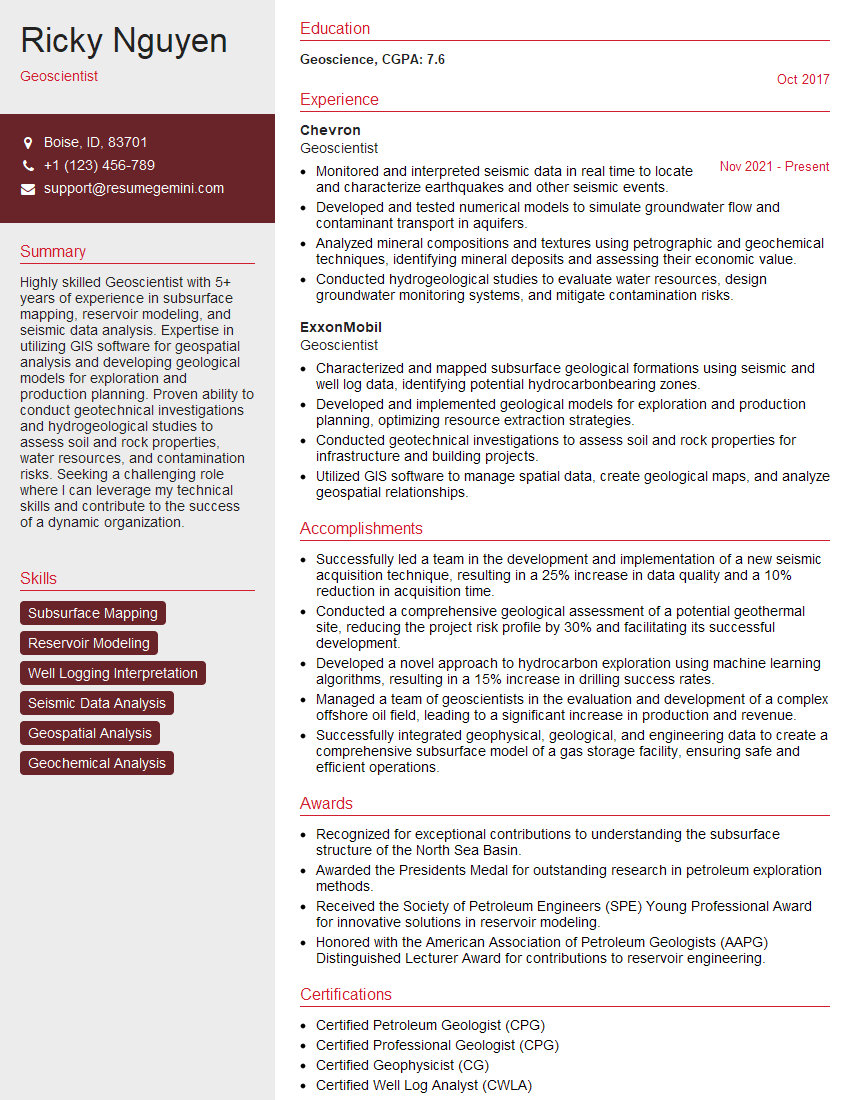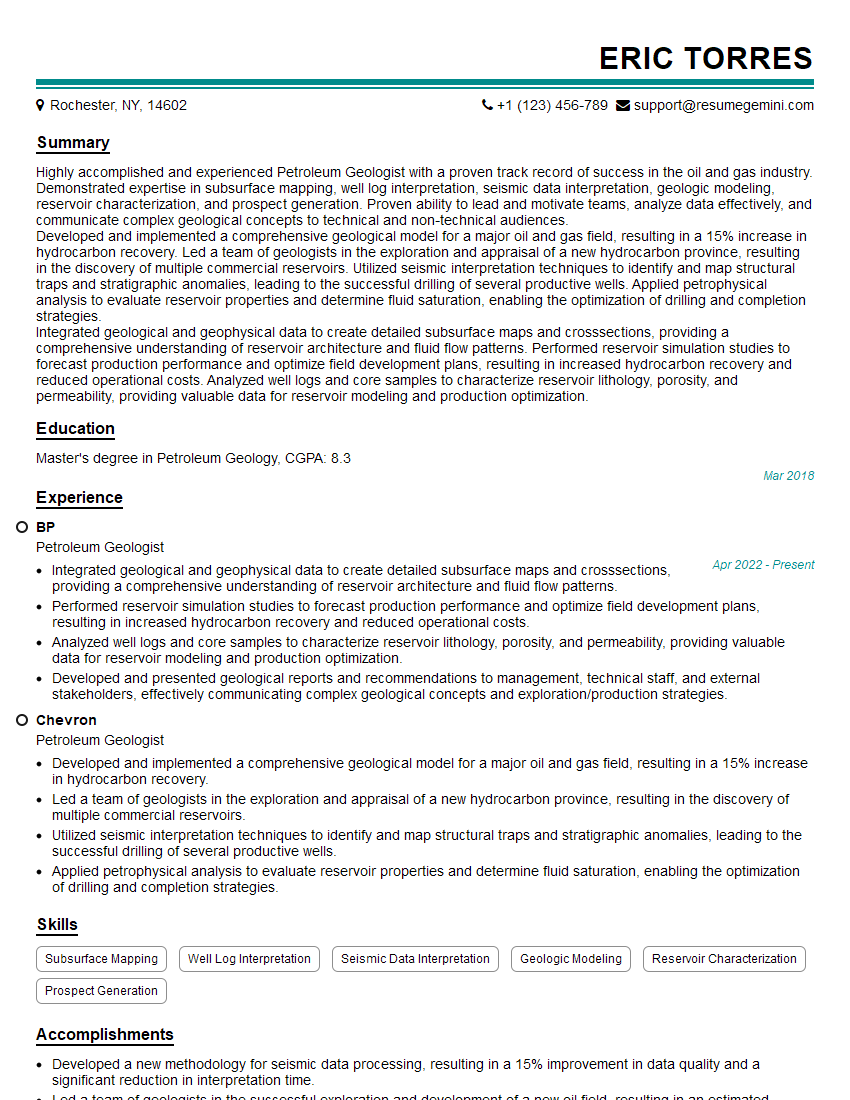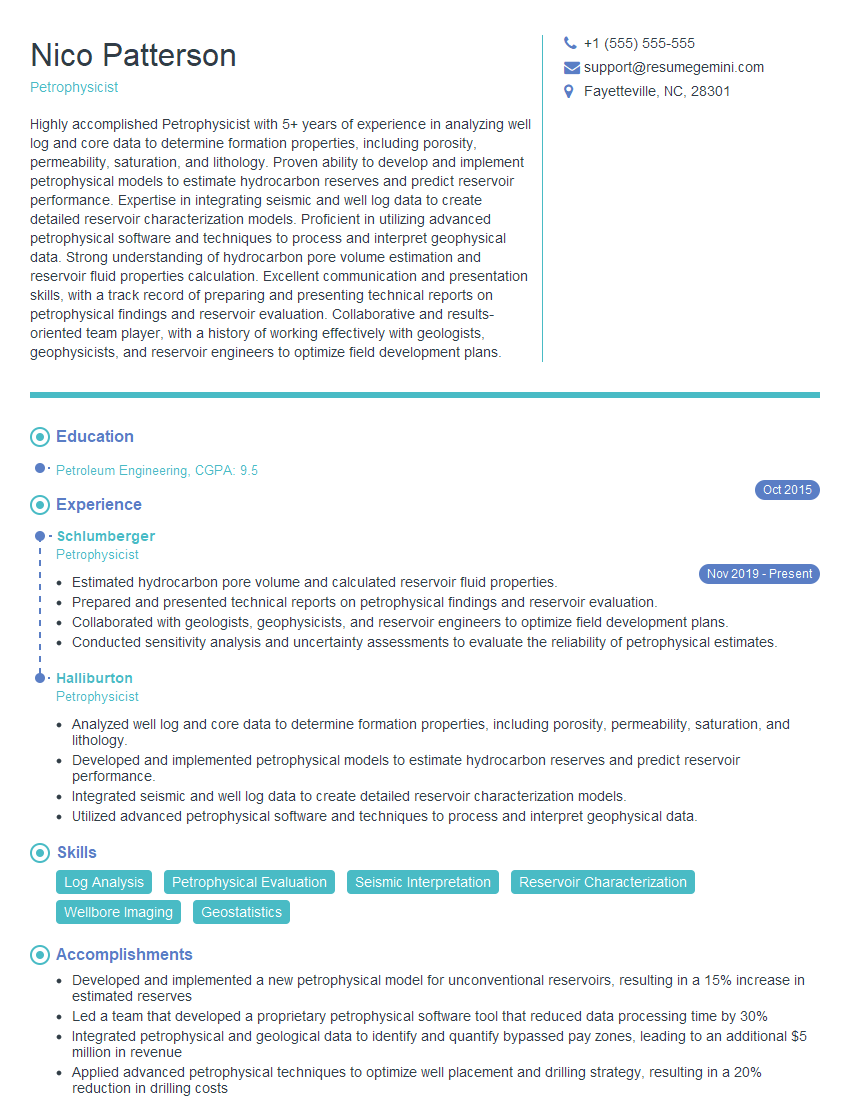Interviews are opportunities to demonstrate your expertise, and this guide is here to help you shine. Explore the essential Geosoft interview questions that employers frequently ask, paired with strategies for crafting responses that set you apart from the competition.
Questions Asked in Geosoft Interview
Q 1. Describe your experience using Geosoft Oasis montaj.
My experience with Geosoft Oasis montaj spans over [Number] years, encompassing a wide range of geophysical data processing and interpretation projects. I’ve utilized its extensive suite of tools for various applications, including mineral exploration, environmental site investigations, and hydrogeological studies. I’m proficient in importing, processing, analyzing, and visualizing diverse datasets, from potential field data (gravity, magnetics) to electromagnetic (EM) and seismic data. A recent project involved processing airborne magnetic data using Oasis montaj to identify potential areas of mineralization, resulting in a significant reduction in exploration costs and improved targeting accuracy. I’m comfortable working with large datasets and optimizing workflows for efficiency and accuracy. My skills extend to using various extension modules within the Oasis montaj environment, as described in further detail below.
Q 2. Explain the difference between various Geosoft modules (e.g., Voxler, GMS, EMAP).
Geosoft offers a modular approach, allowing users to select tools based on their specific needs. Let’s compare three key modules:
- Voxler: This module excels in 3D visualization and interpretation of geophysical and geological data. Imagine having a virtual globe of your subsurface data, allowing you to rotate, zoom, and slice through the data to understand its spatial relationships. Voxler is crucial for building 3D geological models, interpreting complex structures, and creating compelling presentations. For example, I used Voxler to create interactive 3D models of subsurface geology for a mining client, significantly enhancing their understanding of ore body geometry.
- GMS (Geosoft Modeler): This is a powerful tool for creating and interpreting geological models. It’s not just about visualization; it allows you to build models based on constraints from various data types – drillholes, geophysical surveys, geological maps. It enables robust uncertainty analysis and facilitates the integration of multiple datasets into a coherent geological interpretation. For example, using GMS, I successfully integrated geological mapping, drillhole data, and potential field data to develop a 3D model for a hydrogeological study. This improved the understanding of groundwater flow patterns and helped optimize well placement for water resource management.
- EMAP: Designed for processing and interpretation of electromagnetic (EM) data, EMAP is particularly useful for mineral exploration and groundwater investigations. It allows users to process raw EM data, create various types of EM sections, and utilize advanced interpretation techniques like 3D inversion modeling. A project I worked on involved the processing of time-domain EM data using EMAP to map conductive zones indicative of mineral deposits, substantially improving the targeting efficiency.
Q 3. How would you process and interpret gravity data in Geosoft?
Gravity data processing and interpretation in Geosoft involves several key steps:
- Data Import and Editing: I begin by importing the gravity data into Oasis montaj, typically in a format like ASCII or Geosoft’s proprietary format. Any outliers or bad data points are identified and addressed using various editing tools within the software.
- Data Reduction: This stage focuses on correcting for various effects that can distort the gravity data, such as latitude, elevation, terrain, and instrument drift. Geosoft provides tools to perform these corrections efficiently and accurately. This is crucial to remove noise and reveal the underlying geological signals.
- Gridding: I employ appropriate gridding methods (e.g., minimum curvature, kriging) to create a regular grid of gravity values from the corrected data points. The choice of gridding method depends on the nature and distribution of the data and the desired level of smoothing.
- Filtering: Filtering techniques can be applied to enhance the resolution of the data or remove unwanted noise. Various filters, such as upward continuation and reduction to the pole, are available.
- Interpretation: The final step involves interpreting the processed gravity data, often using tools like residual maps, derivatives, and various depth estimation techniques to identify subsurface density contrasts which may indicate geologic structures or mineral deposits. For example, I have used these tools to successfully map buried fault systems and locate subsurface cavities.
Q 4. Explain your workflow for creating a 3D geological model in Geosoft.
My workflow for creating a 3D geological model in Geosoft typically follows these steps:
- Data Acquisition and Compilation: I start by gathering all relevant data, including drillhole data (lithology, geochemistry, assay data), geological maps, geophysical surveys (gravity, magnetics, EM), and any other relevant information.
- Data Preparation and Input: This involves formatting the data into a compatible format for Geosoft GMS, ensuring data quality and consistency. Data cleaning and validation are crucial at this stage.
- Model Building: I utilize GMS to create the 3D geological model. This often involves constructing surfaces representing geological contacts (e.g., stratigraphic horizons, faults), incorporating geological constraints (orientation data, structural interpretations), and constraining the model using the geophysical data.
- Model Validation and Refinement: The model is iteratively refined and validated against the available data. This involves comparing the model predictions with observed data and adjusting the model parameters accordingly. Geophysical inversion and other modeling techniques may be applied to integrate geophysical data more effectively.
- Model Visualization and Analysis: GMS provides tools for visualizing the model in 3D, enabling the extraction of various sections, volumes, and other attributes of interest. This is used for geological interpretation, resource estimation, and other purposes.
Q 5. How do you handle and resolve data discrepancies in Geosoft?
Handling data discrepancies in Geosoft requires a systematic approach:
- Data Validation and Quality Control: I begin by thoroughly examining the data for inconsistencies, errors, or outliers. This often involves using Geosoft’s tools to visualize data, identify problematic data points, and investigate potential reasons for discrepancies (e.g., measurement errors, data entry mistakes).
- Data Editing and Correction: Based on the identified issues, I may edit or correct the data directly within Geosoft, removing outliers, interpolating missing values, or adjusting data points. The correction method should be documented thoroughly to maintain data integrity.
- Investigation and Root Cause Analysis: In some cases, discrepancies may indicate more fundamental issues with the data acquisition or processing workflow. If this is suspected, a root cause analysis is carried out to investigate the issue and prevent similar problems in the future.
- Sensitivity Analysis and Uncertainty Assessment: If discrepancies cannot be fully resolved, I would conduct a sensitivity analysis to assess the impact of uncertain data on the results. This may involve running multiple interpretations with different sets of data to examine the range of possible outcomes.
- Documentation: Any modifications made to the data and the rationale behind them are meticulously documented to ensure transparency and reproducibility of the analysis.
Q 6. What are the strengths and limitations of different gridding techniques in Geosoft?
Geosoft offers a variety of gridding techniques, each with its strengths and weaknesses:
- Minimum Curvature: This method produces smooth surfaces and is particularly useful for potential field data. It is computationally efficient but may over-smooth sharp features.
- Kriging: Kriging is a geostatistical method that takes into account spatial autocorrelation in the data. This produces more accurate interpolations but is more computationally demanding and requires careful parameter selection. It’s excellent when dealing with datasets exhibiting significant spatial variability.
- Inverse Distance Weighting (IDW): IDW is a simple method that weights data points based on their distance to the interpolation location. It is computationally efficient but can be sensitive to outliers and may produce artifacts near data boundaries.
- Natural Neighbour: This method is based on Voronoi diagrams and aims to maintain the local variability of the data. It is useful for irregular data distributions and can handle abrupt changes in data values quite well.
The optimal gridding method depends on the specific characteristics of the data, the desired level of detail, and the computational resources available. For instance, while minimum curvature might suffice for a regional gravity survey, kriging would be preferable for a high-resolution dataset like that from a detailed ground magnetic survey.
Q 7. Describe your experience with Geosoft’s interpretation tools.
My experience with Geosoft’s interpretation tools is extensive. I’m adept at using a wide range of tools for various geophysical data types. This includes:
- Potential Field Interpretation Tools: I routinely use tools for upward continuation, reduction to the pole, analytic signal calculation, and various derivative calculations to enhance the interpretation of gravity and magnetic data. These help highlight subtle anomalies and estimate the depth to subsurface sources.
- 3D Visualization and Modeling Tools (Voxler, GMS): As mentioned earlier, I’m proficient in using Voxler and GMS to create and interpret 3D geological and geophysical models. This includes building geological models, integrating geophysical data, and conducting uncertainty analysis.
- EM Data Interpretation Tools (EMAP): I’m experienced in using EMAP’s tools to process and interpret electromagnetic data, including creating 2D and 3D models of subsurface conductivity.
- Geostatistical Tools: I use Geosoft’s geostatistical tools for data analysis and resource estimation, including kriging and other spatial interpolation techniques. This improves the accuracy of resource modeling.
My experience using these tools has consistently improved my ability to extract meaningful geological and geophysical information from complex datasets, leading to better informed decision-making in various geoscience applications.
Q 8. How familiar are you with different data formats supported by Geosoft?
Geosoft boasts extensive support for a wide array of geophysical and geological data formats. Think of it as a universal translator for earth science data. This ensures seamless integration from various sources. Key formats include:
- SEG-Y: The industry standard for seismic reflection data. It’s like the JPEG of the seismic world – widely used and understood.
- ASCII: Simple text files, often used for gridded data or point data. A very basic but versatile format.
- GeoTIFF: A georeferenced TIFF file, excellent for raster data like satellite imagery or airborne surveys. Imagine it as a map image with precise geographical coordinates.
- XYZ: A straightforward format representing three-dimensional data points (X, Y, and Z coordinates). Useful for representing points of interest like drillholes or survey points.
- GDB: Geosoft’s native database format, providing optimal performance and integration within the Geosoft environment.
- Many others: Geosoft also supports various proprietary formats from different geophysical instrument manufacturers and other software packages. It’s highly adaptable to the needs of varied projects.
My experience encompasses working with all of these formats, often needing to convert between them to optimize workflows depending on the project’s needs and the data’s origin.
Q 9. Explain how you would perform data filtering and enhancement in Geosoft.
Data filtering and enhancement in Geosoft are crucial for improving data quality and extracting meaningful geological and geophysical insights. Think of it as cleaning and sharpening an image before analysis. I typically employ several techniques:
- Filtering: This process removes noise or unwanted signals from the data. Common filters include moving average, median, and wavelet transforms. I select the appropriate filter based on the noise characteristics and the desired outcome. For example, a moving average filter would be ideal for smoothing out high-frequency noise in gravity data, preserving the larger-scale trends.
- Trend Removal: This separates the regional trend from the local anomalies. Techniques like polynomial fitting can accomplish this, which is helpful for isolating smaller, but geologically significant features obscured by larger regional patterns. For instance, removing the regional magnetic trend would highlight subtle local magnetic anomalies associated with mineral deposits.
- Enhancement: This process improves the visibility of subtle features. Techniques include various derivative calculations (e.g., horizontal or vertical derivatives), analytic signal computation, and edge detection. These amplify the contrasts in the data, making geological interpretations clearer.
- Gridding: Irregularly sampled data needs to be interpolated onto a regular grid for easier analysis and visualization. Geosoft offers various gridding algorithms such as kriging, inverse distance weighting, and minimum curvature, each with its strengths and weaknesses.
I always carefully assess the data’s characteristics before choosing the appropriate filter or enhancement technique. Over-processing can lead to artifacts and misinterpretation, while insufficient processing might obscure valuable information. The best approach requires both understanding the geophysical methods used to acquire the data and possessing a strong geological understanding of the study area.
Q 10. Describe your experience with depth conversion in Geosoft.
Depth conversion in Geosoft is essential for transforming measured geophysical responses (e.g., magnetic or gravity anomalies) into subsurface depth estimates. It bridges the gap between surface measurements and subsurface geology. I regularly use Geosoft’s tools for various depth conversion methods:
- Forward Modeling: This involves creating a model of the subsurface and calculating the expected geophysical response. By comparing the modeled response to the observed data, we can refine the model and estimate the depths of geological features. It’s like playing a game of “guess the subsurface” until the calculated data closely matches the measured data.
- Inverse Modeling: This is a more sophisticated approach that uses algorithms to find the subsurface model that best fits the observed data. This method is particularly useful for complex geological settings. It’s a more powerful “guess the subsurface” game, using mathematical algorithms to find the most likely solution.
- Depth to Source Calculations: Simplified methods can quickly estimate the depth of simple features. For example, approximating the depth of a magnetic dipole or a gravity contact.
The choice of method depends largely on the complexity of the geological setting and the quality of the geophysical data. In a simpler setting, a rapid depth-to-source estimate might suffice, while for complex structures, a more rigorous forward or inverse modeling approach is necessary. Successful depth conversion involves not only technical proficiency but also careful interpretation guided by geological understanding.
Q 11. How do you assess the quality of geophysical data in Geosoft?
Assessing geophysical data quality in Geosoft involves a multi-faceted approach. It’s like a thorough medical examination of your data. Here’s my standard process:
- Data Visualization: Initial inspection using various Geosoft tools like maps, cross-sections, and 3D visualizations quickly reveals obvious data issues, such as outliers or gaps in coverage. These are like seeing a broken bone in an X-ray.
- Statistical Analysis: Examining histograms, mean, standard deviation, and other statistical parameters helps identify anomalous values or inconsistencies in data distribution. This is like checking vital signs to find issues that aren’t immediately apparent.
- Noise Assessment: Identifying the types and sources of noise is crucial. This involves examining the frequency content of the data and comparing it to known noise sources. This is like listening to sounds and finding where the unwanted noises are originating.
- Instrument Calibration Check: Verifying that instrument calibration data is available and accurate is essential for reliable interpretation. This is like checking the accuracy of your measuring tools.
- Spatial Consistency Check: Assessing the consistency of data across different surveys or measurement lines is vital. This involves looking for discrepancies or overlaps in data collection that could indicate problems with the survey design or execution. This is like ensuring consistency in the data across all your measurements.
Once these assessments are made, appropriate data processing and filtering techniques are employed to improve data quality. Documenting these steps carefully ensures the integrity and reproducibility of the analysis. Ultimately, understanding the data acquisition methods, survey design and geology of the area is crucial for proper interpretation and quality assessment. The goal is to create trustworthy and reliable data for geological interpretations.
Q 12. Explain your process for creating and interpreting geological maps in Geosoft.
Creating and interpreting geological maps in Geosoft is a process involving data integration, spatial analysis, and geological interpretation. Think of it as building a 3D geological puzzle with all the pieces perfectly fitted. My workflow typically involves:
- Data Import and Management: Importing and organizing diverse datasets, including geophysical data, drillhole data, geological logs, and other relevant information into a Geosoft project.
- Geophysical Data Processing: Filtering, enhancing, and interpreting geophysical data to identify subsurface structures and geological boundaries. This often involves creating various maps and cross-sections to visualize the data.
- Drillhole Data Integration: Incorporating drillhole data, including lithology, geochemistry, and assay results, to constrain and verify interpretations from geophysical data. These data points are crucial for testing and ground-truthing the geophysical interpretation.
- Geological Modeling: Creating geological models using Geosoft’s 3D modeling tools. This involves generating subsurface representations of geological units based on interpreted geophysical and geological data.
- Map Creation and Interpretation: Generating geological maps using various techniques and symbols for clear and effective communication. This is the final product of the analysis that is shared with a wider audience.
Geological map interpretation involves integrating all the available data to build a coherent understanding of the subsurface geology. This is an iterative process, going back and forth between different data sets and interpretations until a satisfactory geological model emerges.
Q 13. What is your experience with using Geosoft for multi-parameter geophysical data integration?
Geosoft excels at integrating multi-parameter geophysical data. It’s like a conductor leading an orchestra of geophysical datasets, ensuring that each instrument plays its part harmoniously. My experience includes integrating various datasets, such as:
- Magnetic and Gravity Data: Combining these datasets improves resolution and reduces ambiguities in subsurface interpretations. Magnetic data is great for identifying magnetic materials, while gravity is sensitive to density contrasts. Together, they provide a more complete picture.
- Seismic and Electromagnetic Data: Combining seismic reflection data (for deeper structures) with electromagnetic data (for shallow conductivity contrasts) can resolve the structural complexity and conductivity distribution of a geological region.
- Geochemical and Geological Data: Incorporating geochemical data from soil samples, drill cores, and geological maps enhances our understanding of the geological context and facilitates accurate interpretations of geophysical anomalies.
The key to successful multi-parameter integration is understanding the individual strengths and limitations of each dataset. Geosoft provides tools for visualizing these different datasets together, allowing for effective cross-correlation and integrated interpretation. For example, I’ve used Geosoft to visualize seismic sections alongside gravity maps, helping correlate depth estimates of subsurface features.
Q 14. How would you use Geosoft to identify potential mineral deposits?
Geosoft is a powerful tool for identifying potential mineral deposits. It’s like a high-tech metal detector, capable of pinpointing areas of high mineral potential. My approach involves:
- Regional-Scale Surveys: First, I’d analyze regional geophysical data (like aeromagnetic or gravity data) to identify large-scale structural features and geological trends that might host mineral deposits. This is like scanning a large area for promising targets.
- Detailed Surveys: Once promising areas are identified, I use high-resolution geophysical surveys (ground magnetics, induced polarization, etc.) to pinpoint specific targets. This is like zooming in on promising areas to find specific targets.
- Data Integration and Interpretation: I then integrate the geophysical data with geological and geochemical data to refine my interpretations. This is like verifying findings with multiple sources of information.
- 3D Modeling: Geosoft’s 3D modeling capabilities enable the creation of realistic subsurface models of potential ore bodies, helping in visualizing the geological context and predicting the size and grade of deposits. This provides a visualization of the potential mineral deposit.
- Targeting and Drillhole Planning: Finally, I use the integrated data to guide exploration drilling, maximizing the chances of discovery. This guides further explorations to confirm the potential.
The success of this approach hinges upon sound geological understanding, appropriate survey design and the ability to synthesize multiple sources of data to create coherent interpretations. Geosoft facilitates this entire workflow providing tools and the framework to process and visualize the data.
Q 15. Explain your experience in using Geosoft for seismic interpretation.
My experience with Geosoft for seismic interpretation spans several years and diverse projects. I’ve extensively used Oasis Montaj to interpret 2D and 3D seismic data, focusing on tasks like horizon picking, fault interpretation, and attribute analysis. For instance, on a recent project involving offshore oil exploration, I utilized Geosoft’s powerful visualization tools to create detailed 3D models of subsurface structures, identifying potential hydrocarbon reservoirs by analyzing seismic attributes like amplitude, frequency, and instantaneous phase. This involved carefully picking key horizons and using the software’s tools to map faults and other geological features. Furthermore, I have experience integrating seismic data with other geophysical datasets (e.g., gravity, magnetic) within the Geosoft environment to build a more comprehensive subsurface understanding.
Specifically, I am proficient in using functionalities such as:
- Horizon tracking and automated picking tools for improved efficiency and accuracy.
- Seismic attribute analysis to delineate reservoir properties and potential hydrocarbon traps.
- Integration of seismic data with well logs for accurate calibration and geological interpretation.
- Creation of high-quality maps and cross-sections to effectively communicate geological interpretations to stakeholders.
Career Expert Tips:
- Ace those interviews! Prepare effectively by reviewing the Top 50 Most Common Interview Questions on ResumeGemini.
- Navigate your job search with confidence! Explore a wide range of Career Tips on ResumeGemini. Learn about common challenges and recommendations to overcome them.
- Craft the perfect resume! Master the Art of Resume Writing with ResumeGemini’s guide. Showcase your unique qualifications and achievements effectively.
- Don’t miss out on holiday savings! Build your dream resume with ResumeGemini’s ATS optimized templates.
Q 16. Describe how you would use Geosoft to create and manage a large geophysical database.
Managing large geophysical databases effectively within Geosoft involves leveraging its database management capabilities. I typically start by organizing the data into a logical structure, often using Geosoft’s GDB (Geosoft Database) format. This allows for efficient storage and retrieval of various geophysical datasets, including seismic data, well logs, gravity, magnetic, and electromagnetic surveys. For particularly large datasets, I might consider partitioning the data into smaller, more manageable GDBs. A crucial aspect is implementing a robust metadata management system to ensure data traceability and integrity. This involves documenting data sources, acquisition parameters, processing steps, and any relevant geological information.
Furthermore, I utilize Geosoft’s database tools for data querying, filtering, and manipulation to extract specific subsets for analysis or visualization. Think of it like organizing a massive library – you need a well-defined system to find what you need quickly and efficiently. I also use the tools to ensure data consistency and identify potential errors or outliers within the database. This might involve cross-referencing data from multiple sources or employing automated quality control checks.
Q 17. How proficient are you in using Geosoft’s scripting capabilities?
I am highly proficient in Geosoft’s scripting capabilities, primarily using EarthScript. I regularly use it to automate repetitive tasks, develop custom processing workflows, and create specialized tools for specific geological interpretations. For example, I have developed EarthScript code to automate the extraction of specific seismic attributes from large datasets, streamlining my workflow considerably. This automation not only saves time but also significantly reduces the risk of human error. Another example would be using EarthScript to create custom tools for interactive interpretation, such as automated horizon picking based on specific criteria. This adds flexibility and efficiency to interpretation that the standard tools alone can’t provide.
My EarthScript skills extend to integrating Geosoft with other software packages, further enhancing the flexibility and power of my workflow. I can easily share and reuse my scripts, which are well-documented to ensure they are easily understood and maintained. Think of EarthScript as a powerful tool for crafting custom solutions—it allows you to tailor Geosoft to your specific needs and project requirements.
Example: //Simple EarthScript example to get file names in a directory var files = GetFiles("C:\MyData", ".dat");Q 18. How do you ensure data accuracy and integrity within Geosoft projects?
Data accuracy and integrity are paramount. My approach to this in Geosoft projects is multi-faceted. It begins with rigorous data validation during the import process, meticulously checking headers, units, and data ranges for inconsistencies or errors. I leverage Geosoft’s built-in data quality control tools to identify and flag outliers or suspicious data points. Metadata is crucial; complete and accurate documentation is maintained throughout the entire project lifecycle. This includes information on data sources, processing steps, and any known limitations or uncertainties.
Version control is essential – I regularly save different versions of my project and maintain a detailed log of changes, allowing for easy rollback to previous states if needed. Finally, peer review is invaluable. Before finalizing any interpretations, I ensure that my work is reviewed by another qualified geoscientist to verify the accuracy and consistency of the results. This collaborative approach minimizes errors and builds confidence in the final output.
Q 19. Describe your experience with Geosoft’s reporting and visualization tools.
I have extensive experience utilizing Geosoft’s reporting and visualization tools to effectively communicate complex geological information. I regularly create high-quality maps, cross-sections, 3D models, and customized reports. These visualizations are tailored to the specific needs of the audience, ranging from technical reports for internal review to presentations for stakeholders with less technical expertise. For instance, for a recent environmental assessment, I generated a series of user-friendly maps showcasing contaminant plumes, using Geosoft’s mapping tools to enhance the visual clarity and effectively communicate the risks to decision-makers.
Beyond the standard tools, I utilize custom report templates and advanced mapping functionalities to tailor the visual presentation to enhance understanding and impact. The goal is not just to present data, but to convey a clear and compelling narrative that supports my geological interpretations. This involves careful selection of color schemes, symbols, and annotations to emphasize key findings and patterns.
Q 20. Explain your understanding of the geological concepts applied in Geosoft workflows.
My understanding of geological concepts is deeply intertwined with my Geosoft workflows. I apply geological principles at every stage, from data acquisition planning and processing to interpretation and modeling. For example, understanding structural geology is crucial when interpreting faults and folds on seismic sections, and I use Geosoft to build 3D models reflecting these structures. Similarly, my knowledge of stratigraphy helps in correlating horizons and interpreting depositional environments, while understanding geophysics allows me to interpret data from various sources (e.g., gravity, magnetic) in conjunction with seismic data.
In essence, Geosoft serves as a powerful tool to help visualize and analyze geological data, but the interpretation itself is firmly rooted in my understanding of geological principles. The software facilitates the process, but the underlying geological knowledge drives the analysis and the conclusions.
Q 21. How do you troubleshoot common Geosoft errors and issues?
Troubleshooting Geosoft issues is a regular part of my workflow. My approach is systematic and starts with identifying the nature of the error. This involves careful review of error messages and logs. Simple issues like incorrect file paths or missing data are quickly resolved by checking basic things first. More complex issues often require a deeper dive into the software’s documentation or online resources such as the Geosoft community forum.
If the problem persists, I leverage my EarthScript skills to create simple diagnostic scripts or utilize Geosoft’s debugging tools. When necessary, I contact Geosoft support for assistance. Experience has taught me the importance of systematically documenting the steps taken during troubleshooting, ensuring that the problem can be effectively addressed and solutions recorded for future reference. This includes logging the steps taken, results obtained, and any changes made.
Q 22. How would you optimize your Geosoft workflow for speed and efficiency?
Optimizing a Geosoft workflow for speed and efficiency involves a multi-pronged approach focusing on data handling, processing techniques, and software settings. Think of it like streamlining an assembly line – each step needs to be efficient to maximize overall output.
Data Pre-processing: Before importing massive datasets into Oasis montaj, pre-processing them externally can drastically reduce processing time. This includes tasks like filtering noisy data, applying corrections (e.g., for diurnal variations in geophysical surveys), and converting data formats to more efficient ones that Geosoft handles optimally.
Using Database Management: Geosoft’s database capabilities are crucial. Properly structuring and indexing your data using GDBs (Geosoft Databases) ensures quick retrieval. Instead of loading entire datasets, only load the necessary portions for a given task.
Efficient Processing Techniques: Choose appropriate algorithms and parameters. For instance, when gridding, selecting a suitable gridding method (e.g., minimum curvature for smooth surfaces, Kriging for more detailed interpolation) and adjusting parameters like search radius significantly impacts speed and accuracy. Using multi-processing capabilities (where available) within the software can further improve speed.
Leveraging Geosoft’s Tools: Tools like the Voxel Modeler and the Map Info Viewer allow for rapid visualization and analysis without needing to constantly re-process the data. Mastering these tools will save considerable time.
Regular Software Updates: Geosoft frequently releases updates with performance improvements. Staying up-to-date ensures you are using the most efficient version.
Q 23. What are the best practices for data management in Geosoft?
Effective data management in Geosoft is paramount for project success and collaboration. It’s like organizing a well-stocked library – easy to find what you need when you need it.
Organized Project Structure: Create a logical folder structure for each project, separating raw data, processed data, interpretations, and reports. This minimizes confusion and streamlines access.
Geosoft Databases (GDBs): GDBs are the backbone of Geosoft data management. They allow for efficient storage and retrieval of various data types, facilitating quick access during analysis. Use meaningful names and descriptions for your GDBs and datasets.
Metadata Management: Accurate and comprehensive metadata is essential. It includes information about data acquisition, processing steps, and quality control checks. This ensures data traceability and reproducibility.
Version Control: Implement a version control system (e.g., using Geosoft’s project archiving features or external solutions like Git) to track changes and revert to previous versions if needed.
Regular Backups: Perform regular backups of your data to prevent loss due to hardware failure or accidental deletion. This is crucial for protecting your valuable work.
Q 24. Describe a challenging Geosoft project you worked on and how you overcame its difficulties.
In one project, we were tasked with integrating diverse geophysical datasets (magnetic, gravity, and electromagnetic) over a large, complex terrain for mineral exploration. The challenge was the significant variation in data quality and density, along with the need for rapid interpretation.
To overcome this, we employed a multi-step approach:
Data Cleaning and Pre-processing: We started by thoroughly cleaning and pre-processing each dataset, handling noise and outliers effectively.
Integrated Modeling: We used Oasis montaj’s 3D modeling capabilities to build integrated models from the processed data, incorporating geological constraints where available.
Inversion Techniques: We applied advanced 3D inversion techniques to improve the resolution of subsurface features.
Geostatistical Analysis: Geostatistical tools were used to create reliable interpolation maps from sparse data areas.
Visualization and Interpretation: We leveraged Oasis montaj’s visualization tools to create compelling 3D models and cross-sections, facilitating effective interpretation.
This systematic approach enabled us to integrate the diverse datasets effectively, leading to a successful mineral resource estimation.
Q 25. How would you collaborate with other geoscientists using Geosoft in a team environment?
Collaboration in Geosoft is enhanced through features that support teamwork. It’s like a shared workspace, ensuring everyone works on the same page.
Shared Databases: Utilizing shared GDBs allows multiple users to access and modify data simultaneously (with appropriate access control). This ensures everyone works with the latest version.
Project Sharing: Geosoft allows for sharing entire projects, allowing team members to work collaboratively on the same set of data and interpretations.
Version Control: Using a version control system, even a simple one integrated into Geosoft, minimizes conflicts and ensures transparency of changes made by each team member.
Regular Meetings and Communication: Effective communication is vital. Regular team meetings and shared documentation (using platforms like Sharepoint) facilitates efficient collaboration and prevents duplication of effort.
Standardized Procedures: Establishing standardized workflows and naming conventions minimizes confusion and improves overall efficiency.
Q 26. What are your plans for continuing to develop your Geosoft skills?
My plan involves a continuous learning approach to improve my Geosoft skills. This includes a blend of formal training and self-directed learning.
Formal Training: I aim to participate in advanced Geosoft workshops to gain expertise in areas like 3D modeling, advanced geostatistics, and specialized application modules.
Self-directed Learning: I will utilize Geosoft’s online resources, tutorials, and webinars to enhance my understanding of new features and techniques.
Practical Application: Applying my knowledge to real-world projects is essential for reinforcement. I will actively seek projects requiring advanced Geosoft applications to refine my skills.
Networking: Engaging with other Geosoft users, attending conferences, and joining online communities provides opportunities to learn from others’ experiences and share best practices.
Q 27. How do you stay updated on the latest Geosoft software features and updates?
Staying updated on the latest Geosoft features and updates requires a proactive approach.
Geosoft Website: Regularly checking the Geosoft website for announcements of new releases, webinars, and training materials.
Geosoft Newsletters and Emails: Subscribing to Geosoft’s newsletters and email alerts provides timely updates on new features and software releases.
User Forums and Communities: Participating in online forums and communities allows access to discussions among other Geosoft users, often highlighting recent changes and helpful tips.
Attending Conferences and Workshops: Attending industry conferences and Geosoft-specific workshops offers opportunities to learn about the latest developments firsthand.
Q 28. Describe your familiarity with the application of Geosoft in a specific industry (e.g., mining, oil & gas).
My experience with Geosoft extensively involves its application in the mining industry. I’ve used it across various stages of exploration and production, from early-stage data processing to resource estimation and mine planning.
Exploration: I’ve utilized Geosoft to process and interpret geophysical data (magnetic, gravity, induced polarization, etc.) to delineate potential ore bodies. This involves gridding, contouring, 3D modeling, and advanced geophysical inversion techniques.
Resource Estimation: Geosoft’s geostatistical tools have been crucial for creating grade models and estimating mineral resources, complying with industry standards.
Mine Planning: I’ve used Geosoft’s tools to visualize ore bodies in 3D, helping to optimize mine plans for extraction efficiency and cost-effectiveness. This involves creating pit designs and managing geological and grade controls within the mining process.
My proficiency extends to using various Geosoft modules tailored for geological modeling, such as Voxel Modeler and GOCAD, allowing for the creation of accurate and detailed subsurface representations.
Key Topics to Learn for Geosoft Interview
- Geosoft Oasis montaj Software Suite: Understand the core functionalities, including data import, processing, interpretation, and visualization capabilities. Explore the various modules and their applications.
- Geophysical Data Processing: Master techniques for data cleaning, filtering, and enhancement. Focus on practical applications like noise reduction, data transformations, and gridding.
- Interpretation and Modeling: Learn to interpret geophysical data, identify geological features, and build 2D/3D geological models. Practice applying different interpretation methods and techniques.
- Specific Geophysical Methods: Develop a strong understanding of at least one or two geophysical methods relevant to Geosoft’s applications (e.g., gravity, magnetics, EM, seismic). Be prepared to discuss both theoretical concepts and practical field applications.
- Data Management and Organization: Understand the importance of efficient data management workflows within the Geosoft environment. Be able to discuss strategies for organizing and managing large datasets.
- Problem-Solving and Analytical Skills: Practice applying your knowledge to solve real-world geophysical problems. Be prepared to discuss your approach to tackling complex data interpretation challenges.
Next Steps
Mastering Geosoft significantly enhances your career prospects in the geophysics and earth sciences industries. It opens doors to exciting roles involving advanced data analysis, geological modeling, and resource exploration. To maximize your chances of securing your dream job, it’s crucial to have an ATS-friendly resume that highlights your relevant skills and experience. We strongly encourage you to use ResumeGemini, a trusted resource for building professional and impactful resumes. ResumeGemini provides valuable tools and resources to help you create a compelling application, and we offer examples of resumes tailored to Geosoft to help guide you.
Explore more articles
Users Rating of Our Blogs
Share Your Experience
We value your feedback! Please rate our content and share your thoughts (optional).
What Readers Say About Our Blog
This was kind of a unique content I found around the specialized skills. Very helpful questions and good detailed answers.
Very Helpful blog, thank you Interviewgemini team.



